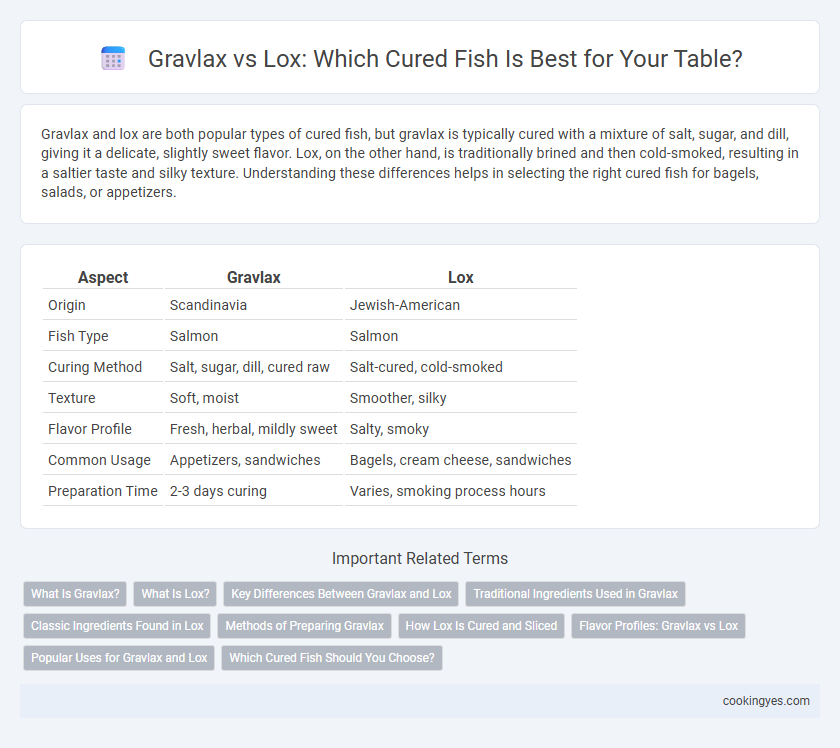Gravlax and lox are both popular types of cured fish, but gravlax is typically cured with a mixture of salt, sugar, and dill, giving it a delicate, slightly sweet flavor. Lox, on the other hand, is traditionally brined and then cold-smoked, resulting in a saltier taste and silky texture. Understanding these differences helps in selecting the right cured fish for bagels, salads, or appetizers.
Table of Comparison
| Aspect | Gravlax | Lox |
|---|---|---|
| Origin | Scandinavia | Jewish-American |
| Fish Type | Salmon | Salmon |
| Curing Method | Salt, sugar, dill, cured raw | Salt-cured, cold-smoked |
| Texture | Soft, moist | Smoother, silky |
| Flavor Profile | Fresh, herbal, mildly sweet | Salty, smoky |
| Common Usage | Appetizers, sandwiches | Bagels, cream cheese, sandwiches |
| Preparation Time | 2-3 days curing | Varies, smoking process hours |
What Is Gravlax?
Gravlax is a Nordic cured fish dish made by curing raw salmon with a mixture of salt, sugar, and dill, resulting in a delicate, slightly sweet, and herbaceous flavor. Unlike lox, which is typically brined and has a saltier taste, gravlax undergoes a dry cure and often includes aromatic herbs and spices. This curing process preserves the fish without smoking, highlighting the natural texture and rich, buttery profile of the salmon.
What Is Lox?
Lox is a type of cured fish traditionally made by curing salmon in a salt-sugar brine, resulting in a silky, smooth texture and salty flavor. Unlike gravlax, which is cured with a mixture of salt, sugar, and dill without smoking, lox is often cold-smoked or unsmoked, maintaining its delicate consistency. Commonly served thinly sliced on bagels with cream cheese, lox is a staple in Jewish culinary traditions and a popular choice for cured fish.
Key Differences Between Gravlax and Lox
Gravlax is a Nordic dish made by curing raw salmon with a mixture of salt, sugar, and dill, resulting in a subtly sweet and herbaceous flavor, while lox is salmon that is traditionally brined or salt-cured without added sugar or herbs, yielding a saltier and more straightforward taste. Gravlax is cured using a dry cure method, typically over several days, enhancing its delicate texture, whereas lox is often cold-smoked after curing, contributing a smoky aroma and slightly firmer texture. Nutritional profiles differ as gravlax retains a higher moisture content and fresh flavor, while lox's smoking process can decrease moisture but intensify protein concentration.
Traditional Ingredients Used in Gravlax
Gravlax is traditionally prepared using fresh salmon cured with a mixture of salt, sugar, and a generous amount of dill, often accompanied by crushed white pepper and sometimes a hint of aquavit or other spirits to enhance flavor. This Nordic method emphasizes a balance of sweet and savory flavors, allowing the salmon's natural qualities to shine through without heavy smoking. Unlike lox, which is typically brined and cold-smoked, gravlax relies on the curing process alone, making dill and the curing agents essential to its distinctive taste and texture.
Classic Ingredients Found in Lox
Classic ingredients found in lox include thinly sliced, cold-smoked salmon cured with a mixture of salt, sugar, and occasionally white pepper, lending a delicate, salty flavor and silky texture. Unlike gravlax, which incorporates dill, mustard seeds, and other fresh herbs during its curing process, lox emphasizes simplicity and purity of taste achieved through smoking. The absence of herbs and the reliance on precise smoking techniques distinguish lox as a traditional cured fish delicacy, often served on bagels with cream cheese.
Methods of Preparing Gravlax
Gravlax is prepared by curing raw salmon with a mixture of salt, sugar, and dill, allowing the flavors to deeply penetrate the fish over several days in refrigeration. The curing process involves a dry cure method without smoking, resulting in a tender texture with a balanced sweet and salty taste. Unlike lox, gravlax relies on the herbal infusion and slow curing to develop its characteristic flavor and texture.
How Lox Is Cured and Sliced
Lox is traditionally cured through a wet brining process using a salt and sugar solution, which enhances its smooth texture and mild flavor. This method preserves the fish without smoking, differentiating it from gravlax and other cured fish varieties. Sliced paper-thin, lox offers a delicate, silky mouthfeel ideal for bagels and garnishes.
Flavor Profiles: Gravlax vs Lox
Gravlax offers a delicate, slightly sweet flavor infused with dill, sugar, and juniper berries, highlighting the subtle taste of the salmon. Lox presents a saltier, more intense umami experience due to its salt-cure method, often without additional herbs or spices. The texture of gravlax is tender and moist, while lox is firmer and silkier, reflecting their distinct curing processes and flavor profiles.
Popular Uses for Gravlax and Lox
Gravlax is widely used as a Scandinavian appetizer, typically served thinly sliced with mustard-dill sauce, on rye bread or crispbread, highlighting its citrus and dill-infused flavors. Lox, a staple in Jewish-American cuisine, is popularly featured in bagel sandwiches accompanied by cream cheese, capers, and red onions, emphasizing its salty and smoky profile. Both gravlax and lox are prized for their delicate texture and versatility in breakfast or brunch dishes.
Which Cured Fish Should You Choose?
Gravlax offers a mildly sweet and herbaceous flavor achieved by curing salmon with dill, sugar, and salt, making it ideal for those who prefer a fresh, delicate taste. Lox, typically salt-cured and thinly sliced, provides a saltier, more intense flavor profile favored in traditional bagel and cream cheese pairings. Choosing between Gravlax and Lox depends on desired saltiness and preparation style, with Gravlax catering to subtle seasoning lovers and Lox suiting fans of robust, salty cured fish.
Gravlax vs Lox for Cured Fish Infographic

 cookingyes.com
cookingyes.com